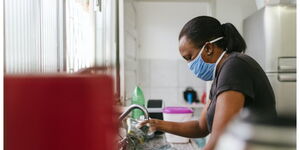Aspiring entrepreneurs are joining the league of farmers minting millions from nutritious fruit, pitaya, also known as the dragon fruit.
Pitaya is currently one of the highest-priced Kenyan fruits selling at between Ksh890 and Ksh3,000 yet it gained traction in Kenya in late 2015.
A vine used to plant the dragon fruit only costs Ksh500.
The scaly, bright red, purple or yellow-skinned tropical fruit can be mistaken for cactus due to its leathery skin that contains some spikes. However, inside it is sweet, juicy and abundant flesh.
The fruits are of two species, distinguished by their colour and taste. The red and purple-fleshed varieties are sweeter than the sour-sweet white-fleshed type.
A single fruit weighs between 600 grams and 1.2 kilograms. Pitaya is rich in fibre, antioxidants, Vitamin C and calcium.
“I can only compare its taste to that of watermelons or strawberries but it is juicier and nutritious, containing protein, carbohydrates, iron, magnesium, fibre, sugars, vitamin A and C," Antony Mugambi, a farmer in Meru County stated.
“The fruit is in high demand especially among Asian nationals in the country; I have orders for a weekly supply of two tons from a Chinese restaurant in Nairobi," Freddie Acosta, a lecturer and a farmer based in Nairobi added.
Among its benefits are that it helps lower cholesterol, enhances the skin’s smoothness and aids diabetes patients to regulate blood sugar levels.
Pitaya plant is beneficial as almost all its parts are consumable. Its roots, flowers and peels are used to make herbal tea, its stem soap is used as wine ingredients and can manufacture juice, yoghurt and smoothies.
“The fruit is not highly perishable because it stops ripening once harvested. With this, it can last for at least 18 days without refrigeration and up to 2 months in the fridge,” Mugambi added in an interview in July 2021.
Farming Conditions & Techniques
Pitayas thrive well in all soil types given they are well-drained and not waterlogged. They can also be produced in containers in a backyard, suitable for urban dwellers. They can grow for 20 to 30 years before declining.
Dragon fruits start flowering in November and fruit in 45 days. Farmers capitalize on the market supply and reduced prices in January/February but prices reportedly hit their peak between July and November prior to the next harvesting cycle.
The plants do not need spraying as they do not attract pests and diseases. They also consume little water lest the occasional manuring and running.
Vines and seeds can both be used to farm pitaya. For seeds, one needs to extract them from their flesh, dry them thoroughly before planting.
1. Select mature cuttings that are at least two years old and over 30cm in length—these take 9 to 18 months before they mature.
Growing from seeds takes four to six years while using cuttings that are undeveloped (less than two years old) take at least two years.
2. Plant them per one concrete post, one or two for wooden poles four inches wide and six feet high
3. Water once or twice a week, though watering frequency is dictated by weather.
4. Spray the plants with organic foliar rich in nitrogen to help enhance growth.
5. Expose them to sunlight 8 hours daily, ideally with an average temperature range of 15-25°C, making it suited to arid and semi regions.
6. Dragon fruits are climbers that can grow up to 30 feet tall. A farmer hence needs to support them through stake and trellis.












